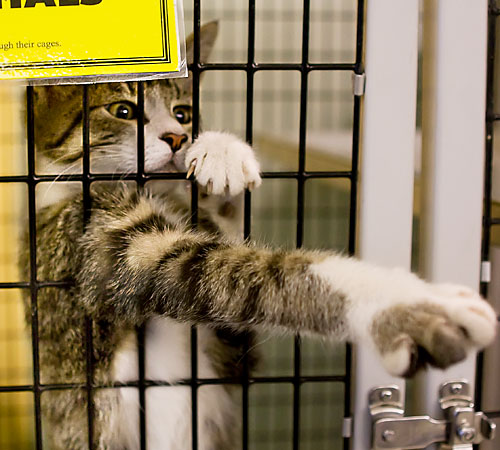Group urges students to make considerations before owning pets

Tiger, a 3-month-old tabby cat reaches out of his cage on Wednesday afternoon. Tiger was dropped off at the Champaign County Humane Society last month by an owner who did not have time to care for him. Students do not always realize the commitment it take Erica Magda
November 13, 2008
It happens every year.
Students sign their first apartment lease, they start buying their own groceries, cleaning their own bathroom, paying their own bills, and living on their own without the comforts and security of a dorm. Some students decide that this is also the time when they should get their own pet, whether it be a beta fish, a guinea pig or a Labrador Retriever, students want their own pet.
The student group Leadership in Action, along with animal science students, wants these potential pet owners to be educated on different parts of animal welfare before making that commitment.
The majority of the group members are enrolled in the College of ACES or earn credit for specific classes in the animal science program.
The group, funded by the U.S. Department of Agriculture, has focused on educating University students about the responsibilities and costs of owning animals.
“Owning a dog costs $1,500 per year,” said Marissa Woodall, a sophomore in ACES and student working with the group. “1,500 bucks is a lot of money.”
Aside from cost problems, students often have extremely sporadic and hectic schedules.
“It is so hard to give them what they need with a college student’s lifestyle and schedule,” said Dr. Amy Fischer, professor of animal sciences. “Dogs especially appreciate routines.”
Some students may adopt animals but then face life changes at the end of the year such as graduation, moving back home or moving to a place where they cannot bring a pet.
“Often times people just leave their pets behind at the end of the semester,” said Blake Ruebush, senior in ACES and member of Leadership in Action.
A number of pet owners bring their animals to the local humane society when they cannot continue to care for the pet, especially at the end of the school year.
“We definitely see an influx of animals coming in during May and June,” said Kate Meghji, shelter manager of the Champaign County Humane Society.
According to the shelter, 1,133 animals were relinquished to the shelter between April and August. Between December and March, only 717 pets were relinquished.
For students who choose to have pets on campus the group suggests some key tips to provide the best care possible.
“It’s really important to build in consistent time to exercise animals,” Fischer said.
Other recommendations include having one person ultimately responsible for care of the animal, neutering the pet, providing stimulations for animals while at class or work such as toys.
The group also plans to post fliers on buses and in the Tenant Union and team up with registered student organizations to have an event on the Quad.
The students are also planning a presentation on their work at the University to the Central Illinois Animal Welfare Coalition in January.
For students who are animal lovers but can’t commit to being owners, Fischer recommended fostering animals and volunteering at the local shelter.
“My number one recommendation is to get involved with an organization,” said Fischer. “They can get involved but have no long-term commitment.”
People who work at the shelter agree.
“It is a commitment, a responsibility much like having a child,” Meghji said. “I’m not opposed (to students having pets) as long as they are ready for a long-term commitment.”




 DI multimedia
DI multimedia


